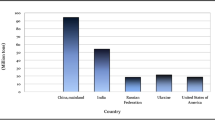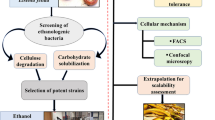Abstract
Agricultural residues were pretreated by steam explosion and the cellulosic component of these substrates were converted to ethanol using a combined enzymatic hydrolysis and fermentation (CHF) process. The enzymatic hydrolysis was carried out using culture filtrates ofTrichoderma harzianum E58 while the liberated sugars were fermented to ethanol byS. cerevisiae.
Initially, pretreatment conditions were optimized to ensure that the substrates were readily hydrolyzed and fermented. The agricultural residues were steamed for various times between 30 and 120 s at approximately 240‡C prior to rapid decompression (explosion) in a small masonite-type gun. The various substrates were selectively extracted by water and alkali to see whether the enzymatic hydrolysis and fermentability of the substrates were enhanced. A comparison between the overall conversion of wheat and barley straw was made since these are the two most readily available agricultural residues in Canada.
Steam explosion did not affect the hexosan content of the residues, although the pentosan content of the substrates decreased with increasing duration of steaming. The hexosan (cellulose) content of wheat straw was 50.7% of the total substrate while a slightly higher 52.9% cellulose content was detected in the barley straw. Wheat straw was more efficiently hydrolyzed after it had been steamed for 90 s while optimum hydrolysis of the barley straw was detected after 60 s.
Steam exploded wheat and barley straw that was subsequently extracted with water was readily hydrolyzed to their component sugars.S. cerevisiae could almost quantitatively convert these sugars to ethanol. This indicated that water washing not only enhanced the enzymatic hydrolysis of the steam exploded substrates, it also removed inhibitory material that restricted the growth of S.cerevisiae.
Maximum hydrolysis (78.5%) and ethanol yields (10 mg/mL) were obtained when wheat straw was steamed for 90 s. Slightly lower hydrolysis (76.0%) and ethanol yields (9.5 mg/mL) were obtained with barley straw that had been steamed for 120 s.
Similar content being viewed by others
Author information
Authors and Affiliations
Rights and permissions
About this article
Cite this article
Mes-Hartree, M., Hogan, C. & Saddler, J.N. The enzymatic hydrolysis of pretreated agricultural residues and the fermentation of the liberated sugars to ethanol. Appl Biochem Biotechnol 9, 389–390 (1984). https://doi.org/10.1007/BF02798990
Issue Date:
DOI: https://doi.org/10.1007/BF02798990




